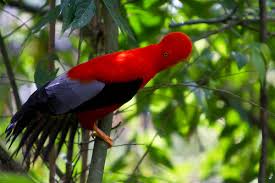The cock of the rock or peruviana Rupícola,
national bird of Peru
Peru has the second
highest number of bird species in the world, considering only endemic species,
it is the first place. In the past 30 years we have discovered new species, two
on average per year, although in recent years many species of animals have
disappeared for various reasons, such as excessive growth of the human
population, overuse of natural resources, and other causes.
The cock of the rock or
tunqui (Quechua tunki) (rupicola peruviana) is a species of passerine bird in
the family Cotingidae. It is the national bird of Peru. Its closest
relative is the Guianan cock rock (rupicola rupicola) and is notable for the
incredible beauty of their plumage. Its exotic form is popular because his
figure has been captured in prints, paintings and photographs are published
everywhere.
It is also called cock
of the rock, cock of the Sierras, the Andean Cock Rock, Tunqui, cock of the
mountain, berreador, chaperone. The Latin name Rupicola peruviana 'means
"[bird] of Peru Peruvian or rocks."
Live in the dense
forests of the high forest lives one of the most beautiful birds de¡ Peru and
is considered the national bird. Its name in Quechua is "tunqui" and
in Spanish is "cock of the rock." The geographical distribution
extends from Venezuela to Bolivia, through Colombia, Ecuador and Peru, between
1400 and 2400 meters above sea level in the forests moist and dense in the
eastern Andean slopes.
In the high
forest, it prefers certain areas of the humid and dense forests, often near
streams and rock faces or cliffs; there may be very common. It is a bird
usually quiet, which only makes sounds when in estrus (a kind of grunting) or
when it is frightened or is removed from its territory (a sound like
"uankk"). It feeds on fruits and insects; predators are eagles,
snakes, ferrets, coatis and some smaller cats.
It is a medium bird
about 32 cm long, with sexual dimorphism in color. The male is a beautiful deep
red-orange color, with orange eyes, beak and yellow-orange legs, an erect crest
of feathers on the beak and forehead, black wings and tail, and some pearl gray
feathers in the wings . The female is dark reddish brown in its entirety and
with the smallest crest.
The female takes care
single incubation and care of offspring. This is because the striking presence
of the male near the nest is dangerous to attract predators like eagles,
snakes, among others. The opaque color of the females then takes a fundamental
value, as it serves to avoid being detected by enemies.
Tunqui is the national
bird of Peru and has legal protection, hunting is prohibited and marketing;
However this provision is not respected and is marketed live or dissected in
many places. For lack of knowledge about their diet, captive animals usually do
not survive for long. It has also completely disappeared due to forest clearing
and illegal hunting that is the subject.
In Peru it is found in
various protected areas like national parks (Rio Abiselo, San Martin; Yanachaga
- Chemillén, Pasco, Tingo Maria, Huanuco, and Manu, Cusco - Mother of God). It
is also in vain protection forests (Alto Mayo, San Martin, San Matías - San
Carlos, Pasco, and Pui-Pui, Junin).
According to report from
the global conservation status by the IUCN, The cock is in state Least Concern
according to the IUCN. The conservation of this species can attract significant
flows of tourists to areas where it is to observe, and produce income to local
people through tourism services.
The cock is not included
in the list of Supreme Decree No. 034-2004-AG, but may eventually be part of
one of the categories.
Article 1.
Approval of the categorization of
threatened wildlife species.
To approve the
categorization of threatened wildlife species, consisting of 301 species, 65
mammals, 172 birds, 26 reptiles and 38 amphibians, equally distributed in the
following categories: critically endangered (CR), Endangered (EN), Vulnerable (
VU) Near Threatened (NT), according to the
attached Annex running part hereof
References
El
Tunqui o Gallito de las Rocas: Ave Nacional del Perú
http://www.peruecologico.com.pe/lib_c12_t11.htm
Gallito
de las rocas
Los 7 Animales
Endémicos en peligro de extinción del Perú
Rupícola
peruviana
DS
034-2004-AG – Aprueban categorización de especies amenazadas de fauna silvestre
(22 setiembre 2004)
Gallito de las rocas
http://www.leyendas.gob.pe/zoologia/especie_individuo.php?esp=128




































